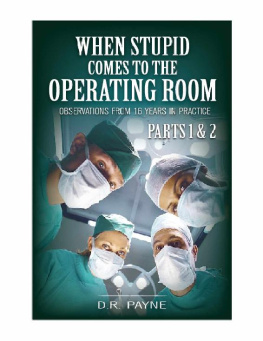When Stupid Comes to the Operating Room
Table of Contents
Dedication
To all my patients and colleagues who made this book possible.
And to my sweet boy, MoMo the sweetest, cutest and smartest puppy I have ever met. And, to Isabelle welcome to the family. You are going to love it here.
Introduction
Okay, the title is a bit of a white lie. The actual title should be When Stupid Comes To The Hospital; I just really preferred the title When Stupid Comes To The Operating Room, since as an anesthesiologist, thats where I usually see them.
I have changed the names and places to protect the guilty.
These stories are aimed mainly at the general (read that as non-medical) population who really have no clue about what those of us in the medical field see and do all day.
I will say the stupid have given me plenty of work. Most of that work has been after-hours; because let's face it, stupid rarely happens between 9 AM and 5 PM Monday through Friday. So there has been lots of overtime related to stupid.
For the most part, I have chosen stories or cases, if you will, in which a choice could easily have been made to go in another direction usually a smarter one. I have changed the states, ages, and all confidential information I deemed necessary to protect the guilty while maintaining the hilarity of the story.
These stories are humorous, and hopefully they will relate that way in my writing. This book is merely a distraction and should not be considered, nor is it written, in a politically correct manner. If that will be an issue for you, then this might not be the book for you.
So sit back, enjoy the next little while, and be thankful you havent done what these people did. Or at least, if you did, you lived through it.
DR Payne has a website now. Posts can be found at the following facebook fan page:
https://www.facebook.com/WhenStupidComestotheOperatingRoom
If you enjoy this book, please take the time to review it on the Amazon Website. The review may help others decide if they would like the book. Here is a quick link to help get you get started:
http://amzn.to/1dMF7Dj
Definitions
Body Mass Index, or BMI
18 Supermodel thin
20-25 Normal
25-30 Overweight
30-40 Obese
40-50 Morbidly Obese
50-60 Super morbidly obese
60-70 Super, super morbidly obese
70-80 Super, super, super morbidly obese
80-90 Super, super, super, super morbidly obese
Now, there are some who argue that the Body Mass Index is an inaccurate tool of measurement, because muscle weighs more than fat. Therefore, if you have lots of muscle on your body, then the BMI can throw you into a higher classification. I will say in my 16 years of practice, I have never seen someone who is fit and muscular over a 30 on the BMI scale. So when we are talking about BMIs greater than 30 lets just assume most of the extra is fat.
Alcohol
The amount of alcohol a person has consumed is measured by Blood Alcohol Content. That is the amount of alcohol in the blood stream. The legal limit for alcohol in the blood is 80 milligrams of alcohol per deciliter of blood this is the driving legal limit. I maintain that this should also be the legal limit for consent for an elective surgery. An emergency surgery is a completely different story. Needless to say, I have had multiple times when I had to cancel non-emergent surgery, like getting your gallbladder out or taking a look in your knee to see why it hurts, because the patients were legally drunk that morning.
Other illicit drugs can prevent us from doing non-emergency surgery as well. These typically include methamphetamines, cocaine, and ecstasy, because these drugs prevent your bodys normal changes under anesthesia.
Normal Operating Room (OR) procedure
My sister said I needed to explain what is normal for a general anesthetic or regional anesthetic for those of you who don't do this on a daily basis.
Those in the room for most procedures include the anesthesia personnel, a surgeon, a circulating nurse, and a scrub tech. The anesthesia personnel may be an anesthesiologist, a CRNA (a specially trained nurse), or both.
General Anesthesia
When we do what is called a general anesthetic, we take you into the operating room and attach monitors. After giving you oxygen to breathe through the mask, we will give you medications through your intravenous (IV) line. We check to make sure that you are very deeply asleep. And after we are sure that you are sleep, we take a small instrument, place it in your mouth and put a breathing tube in. This breathing tube lets us help you breathe, because you are in a deep enough sleep that you're not breathing very well on your own. This is the definition of an intubation. We occasionally have to do this outside of surgery if you are sick and not breathing well enough on your own usually as a temporary measure until you are feeling better and we can take the tube breathing out.
After surgery is completed, we turn off the supply of anesthetics in the IV and breathing tube, wake you up, and take the breathing tube out. Most people never remember the breathing tube. We are there the entire time, making sure that your heart rate, blood pressure, and oxygen saturation are all within normal limits while you're asleep.
Regional Anesthesia
When we do a regional anesthetic, we are numbing just the region of the body that is being operated on. There are many different kinds of regional anesthesia. We can numb just your arm if youre having arm surgery or just your leg if youre having leg surgery. The two most common types of regional anesthetic we do are the spinal anesthetic and the epidural anesthetic. The spinal anesthetic is used when doing surgery on the stomach and lower extremities, such as joint replacement or a C-Section, when you will not need or want prolonged anesthesia. An epidural anesthetic is very similar to a spinal except that we leave a small tube in your back so that more medicine can be put in to keep you numb for a longer period of time. This is especially useful when we have no idea how long you might need anesthesia, like when you are in labor.
For a spinal anesthetic, we take you into the operating room and hook you up to the monitors just like for a general anesthetic. After doing that, we have you sit up, wash your back off with some soap, and numb your skin so that you won't feel the spinal needle going in. The spinal needle is a very small needle, usually much smaller than your IV line. Once we find the spot to put this spinal medicine in, you will begin to get numb from about your waist down. As with the general anesthetic, we stay in the room with you the entire time.
The spinal anesthetic usually lasts for a while after the surgery is completed. We tend to pick the anesthetic and the dose by what we anticipate the length of the surgery to be.
An epidural anesthetic starts out the same way as the spinal. But instead of a really tiny spinal needle, we used a much larger needle that we can thread a tube though to give you continuous anesthesia to prevent pain in your stomach and lower body.
Stupid Things That People Do
So, how far did the potato fly, anyway?
Back in the early 2000s, I had the opportunity to live and practice in a small area of Alaska just outside of Anchorage. I loved it! The views were gorgeous and the people couldnt be nicer. It reminded me quite a bit of the South where I grew up.
Next page











